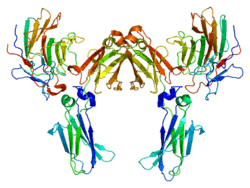Intracellular antibody-mediated degradation
Intracellular antibody-mediated degradation (IAMD) is a neutralization mechanism of intracellular antibody-mediated immunity whereby an effector protein, TRIM21, directs antibody bound virions to the proteasome where they are degraded. As yet, it has only been observed to act against the adenovirus[1] but is likely to also be effective against other non-enveloped viruses.
Mechanism of action

Crystallographic structure of two molecules of the C-terminal PRYSPRY domain of TRIM21 (top right and top left) complexed with homodimeric Ig gamma-1 chain C region (center).[2]
In IAMD, the neutralization of the pathogen follows a non-cytotoxic mechanism.[1] That is, the infected cell is not attacked as in Antibody-dependent cell-mediated cytotoxicity, instead the virions are rapidly destroyed and the cell may be relieved of infection.
- Immunoglobulin G (IgG) binds specifically to the target antigen presented on the pathogen extracellularly
- The antibody bound pathogen infects a host cell
- In the cytosol, TRIM21 (a protein of the Tripartite motif family) binds with high affinity to IgG
- TRIM21 is conjugated with ubiquitin, which directs the complex to the proteasome
- Degradation by proteolysis of both the protein capsid and the antibody occurs, but not the TRIM21 protein
Resistance to mutants
There are a number of reasons why IAMD is so resistant to evasion by mutants through evolution:
- The targeting of pathogens by antibodies is adaptive while the degradation is innate; the overall response therefore combines both adaptive and innate immunity.
- The proteasomal targeting is mediated by the autoubiquitination of TRIM21, there is no direct interaction with the pathogen[1] so mutants which evade ubiquitination themselves cannot evade IAMD.
- Unlike extracellular humoral immune responses, this intracellular mechanism is expressed in most human tissues[1] and is an example of encapsulating immunity as opposed to mere immune surveillance.
See also
References
- 1 2 3 4 Mallery DL, McEwan WA, Bidgood SR, Towers GJ, Johnson CM, James LC (2010). "Antibodies mediate intracellular immunity through tripartite motif-containing 21 (TRIM21)". Proc. Natl. Acad. Sci. U.S.A. 107 (46): 19985–19990. doi:10.1073/pnas.1014074107. PMC 2993423
 . PMID 21045130.
. PMID 21045130. - ↑ PDB: 2IWG; James LC, Keeble AH, Khan Z, Rhodes DA, Trowsdale J (April 2007). "Structural basis for PRYSPRY-mediated tripartite motif (TRIM) protein function". Proc. Natl. Acad. Sci. U.S.A. 104 (15): 6200–5. doi:10.1073/pnas.0609174104. PMC 1851072
 . PMID 17400754.
. PMID 17400754.
This article is issued from Wikipedia - version of the 6/1/2016. The text is available under the Creative Commons Attribution/Share Alike but additional terms may apply for the media files.